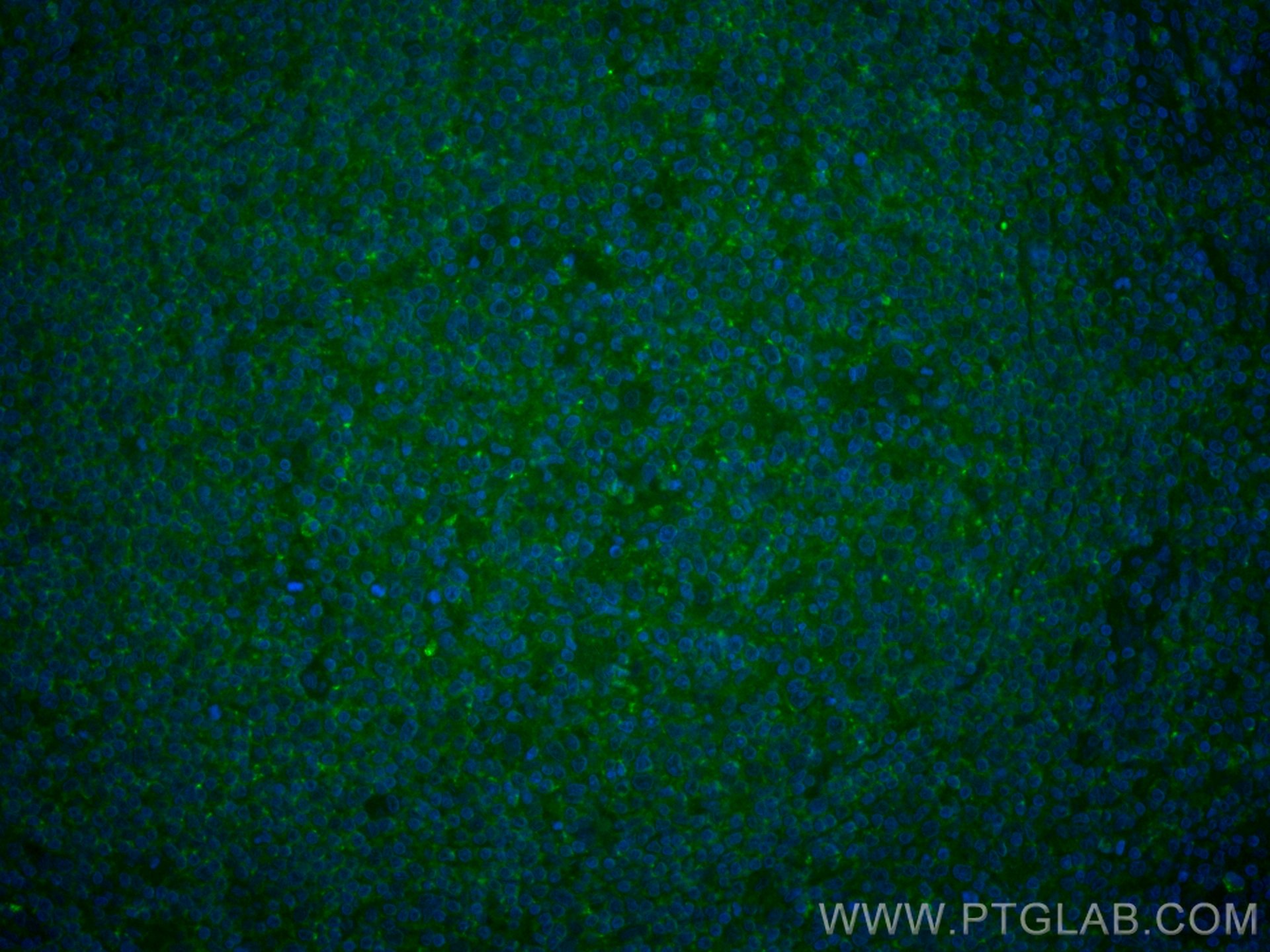Validation Data Gallery
Tested Applications
| Positive IF-P detected in | human tonsillitis tissue |
Recommended dilution
| Application | Dilution |
|---|---|
| Immunofluorescence (IF)-P | IF-P : 1:50-1:500 |
| It is recommended that this reagent should be titrated in each testing system to obtain optimal results. | |
| Sample-dependent, Check data in validation data gallery. | |
Published Applications
| IF | See 2 publications below |
Product Information
CL488-60287 targets CD45 in IF-P applications and shows reactivity with human, mouse, pig samples.
| Tested Reactivity | human, mouse, pig |
| Cited Reactivity | human, mouse |
| Host / Isotype | Mouse / IgG2a |
| Class | Monoclonal |
| Type | Antibody |
| Immunogen | CD45 fusion protein Ag13712 相同性解析による交差性が予測される生物種 |
| Full Name | protein tyrosine phosphatase, receptor type, C |
| Calculated molecular weight | 1304 aa, 147 kDa |
| Observed molecular weight | 220 kDa |
| GenBank accession number | BC014239 |
| Gene Symbol | CD45 |
| Gene ID (NCBI) | 5788 |
| ENSEMBL Gene ID | ENSG00000081237 |
| RRID | AB_2919245 |
| Conjugate | CoraLite® Plus 488 Fluorescent Dye |
| Excitation/Emission maxima wavelengths | 493 nm / 522 nm |
| Form | Liquid |
| Purification Method | Protein A purification |
| UNIPROT ID | P08575 |
| Storage Buffer | PBS with 50% glycerol, 0.05% Proclin300, 0.5% BSA , pH 7.3 |
| Storage Conditions | Store at -20°C. Avoid exposure to light. Stable for one year after shipment. Aliquoting is unnecessary for -20oC storage. |
Background Information
Protein tyrosine phosphatase receptor type C (PTPRC) is also known as CD45 antigen, which was originally called leukocyte common antigen (LCA). CD45 is an enzyme required for T-cell activation through the antigen receptor consisting of two intracellular phosphatase domains, a transmembrane domain and an extracellular domain. Upon T-cell activation, CD45 recruits and dephosphorylates SKAP1 via an interaction through the first PTPase domain, which is the only domain to possess intrinsic kinase activity. However, both domains are required for appropriate phosphatase and T-cell antigen receptor activity (PMID: 8076596).
What is the molecular weight of CD45?
The molecular weight of CD45 is a 180-240 kDa.
What are the isoforms of CD45?
Six different human isoforms of CD45 have been isolated, containing all three exons (ABC isoform), two of the three exons (AB and BC isoforms), only one exon (A isoform or B isoform), or no exons (O isoform). All of the isoforms have the same eight amino acids at their amino-terminus (PMID: 12412720).
What is the tissue specificity of CD45?
CD45 is a tyrosine phosphatase expressed on the plasma membrane of all hematopoietic cells, except erythrocytes and platelets (PMID: 7803253).
What are the post-translational modifications of CD45?
CD45 can be heavily N- and O-glycosylated (PMID: 1702721).
What is CD45's involvement in disease?
Defects in CD45 are a cause of severe combined immunodeficiency autosomal recessive T-cell-negative/B-cell-positive/NK-cell-positive (T(-)B(+)NK(+) SCID); a severe form of SCID. It is classed by the impairment of both humoral and cell-mediated immunity, leukopenia, and the low or absent levels of antibodies (PMID: 10700239). Also, genetic variants of CD45 have a role in susceptibility to multiple sclerosis (PMID: 12864992).
Protocols
| Product Specific Protocols | |
|---|---|
| IF protocol for CL Plus 488 CD45 antibody CL488-60287 | Download protocol |
| Standard Protocols | |
|---|---|
| Click here to view our Standard Protocols |
Publications
| Species | Application | Title |
|---|---|---|
J Virol Ex Vivo Infection of Human Skin with Herpes Simplex Virus 1 Reveals Mechanical Wounds as Insufficient Entry Portals via the Skin Surface | ||
Biosens Bioelectron Constructing a highly sensitive duplex immunoassay using AuNPs and AgNPs as nanolabels for investigating the epithelial-mesenchymal transition occurring on circulating tumor cells with lung cancer patients |
